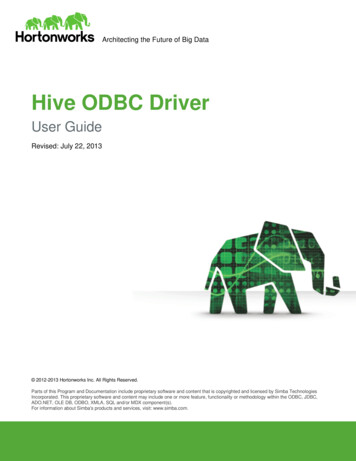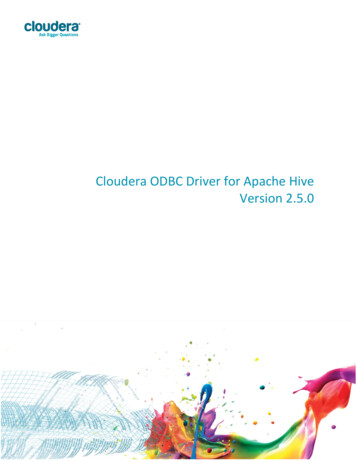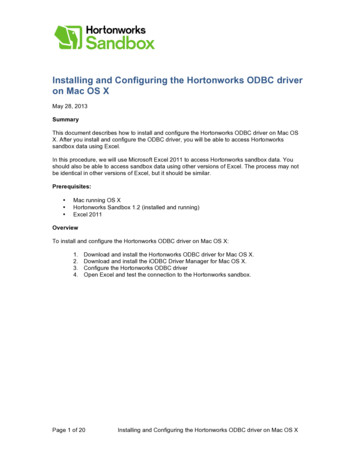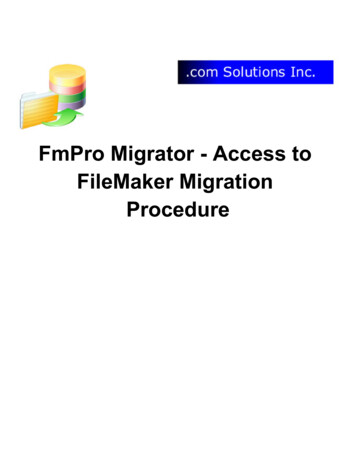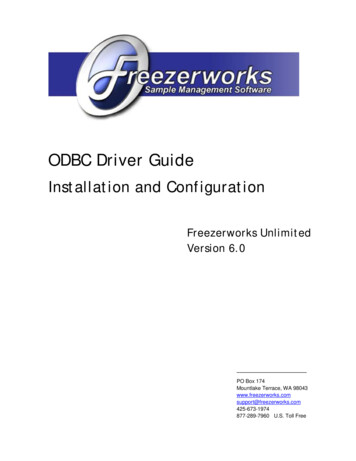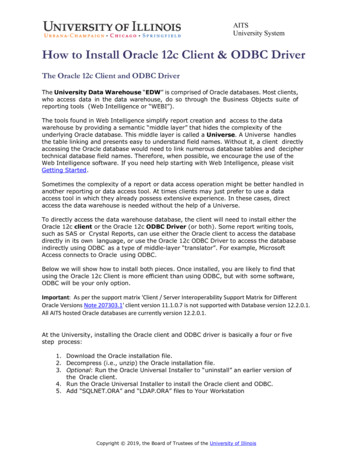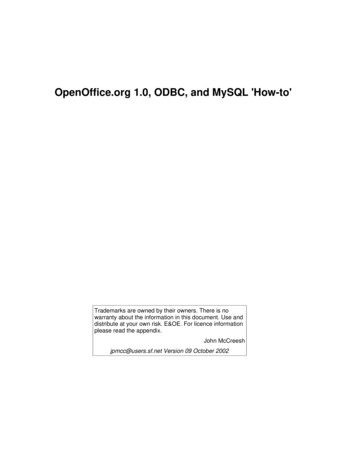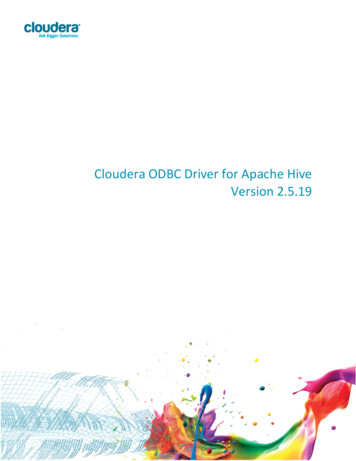
Transcription
Cloudera ODBCDriver for ApacheHive
Important Notice 2010-2020 Cloudera, Inc. All rights reserved.Cloudera, the Cloudera logo, and any other product or service names or slogans contained in thisdocument, except as otherwise disclaimed, are trademarks of Cloudera and its suppliers orlicensors, and may not be copied, imitated or used, in whole or in part, without the prior writtenpermission of Cloudera or the applicable trademark holder.Hadoop and the Hadoop elephant logo are trademarks of the Apache Software Foundation. Allother trademarks, registered trademarks, product names and company names or logosmentioned in this document are the property of their respective owners. Reference to anyproducts, services, processes or other information, by trade name, trademark, manufacturer,supplier or otherwise does not constitute or imply endorsement, sponsorship orrecommendation thereof by us.Complying with all applicable copyright laws is the responsibility of the user. Without limiting therights under copyright, no part of this document may be reproduced, stored in or introduced intoa retrieval system, or transmitted in any form or by any means (electronic, mechanical,photocopying, recording, or otherwise), or for any purpose, without the express writtenpermission of Cloudera.Cloudera may have patents, patent applications, trademarks, copyrights, or other intellectualproperty rights covering subject matter in this document. Except as expressly provided in anywritten license agreement from Cloudera, the furnishing of this document does not give you anylicense to these patents, trademarks copyrights, or other intellectual property.The information in this document is subject to change without notice. Cloudera shall not be liablefor any damages resulting from technical errors or omissions which may be present in thisdocument, or from use of this document.Cloudera, Inc.1001 Page Mill Road, Building 2Palo Alto, CA 94304-1008info@cloudera.comUS: 1-888-789-1488Intl: 1-650-843-0595www.cloudera.comRelease InformationVersion: 2.6.11Date: March 26, 20212 Cloudera ODBC Driver for Apache Hive
Table of ContentsABOUT THE CLOUDERA ODBC DRIVER FOR APACHE HIVE5WINDOWS DRIVER6WINDOWS SYSTEM REQUIREMENTS6INSTALLING THE DRIVER ON WINDOWS6CREATING A DATA SOURCE N AME ON WINDOWS7CONFIGURING A DSN-LESS CONNECTION ON WINDOWS10CONFIGURING A UTHENTICATION ON WINDOWS12CONFIGURING A DVANCED O PTIONS ON WINDOWS17CONFIGURING A PROXY CONNECTION ON WINDOWS19CONFIGURING HTTP O PTIONS ON WINDOWS20CONFIGURING SSL V ERIFICATION ON WINDOWS21CONFIGURING THE TEMPORARY TABLE FEATURE22CONFIGURING SERVER -SIDE PROPERTIES ON WINDOWS23CONFIGURING L OGGING O PTIONS ON WINDOWS24CONFIGURING KERBEROS A UTHENTICATION FOR WINDOWS27V ERIFYING THE DRIVER V ERSION N UMBER ON WINDOWS31MAC OSDRIVER32MAC OS SYSTEM REQUIREMENTS32INSTALLING THE DRIVER ON MAC OS32V ERIFYING THE DRIVER V ERSION N UMBER ON MAC OS32L INUX DRIVER34L INUX SYSTEM REQUIREMENTS34INSTALLING THE DRIVER U SING THE RPM FILE34INSTALLING THE DRIVER ON DEBIAN35V ERIFYING THE DRIVER V ERSION N UMBER ON L INUX36AIX DRIVER38AIX SYSTEM REQUIREMENTS38INSTALLING THE DRIVER ON AIX38V ERIFYING THE DRIVER V ERSION N UMBER ON AIX39CONFIGURING THE ODBC DRIVER M ANAGER ON N ON-WINDOWS M ACHINES40SPECIFYING ODBC DRIVER MANAGERS ON N ON-WINDOWS MACHINES40SPECIFYING THE L OCATIONS OF THE DRIVER CONFIGURATION FILES40CONFIGURING ODBC CONNECTIONS ON A N ON-WINDOWS M ACHINE42CREATING A DATA SOURCE N AME ON A N ON-WINDOWS MACHINE42CONFIGURING A DSN-LESS CONNECTION ON A N ON-WINDOWS MACHINE45Cloudera ODBC Driver for Apache Hive 3
CONFIGURING SERVICE DISCOVERY MODE ON A N ON-WINDOWS MACHINE47CONFIGURING A UTHENTICATION ON A N ON-WINDOWS MACHINE47CONFIGURING SSL V ERIFICATION ON A N ON-WINDOWS MACHINE51CONFIGURING SERVER -SIDE PROPERTIES ON A N ON-WINDOWS MACHINE52CONFIGURING L OGGING O PTIONS53SETTING DRIVER -WIDE CONFIGURATION O PTIONS ON A N ON-WINDOWS MACHINE54TESTING THE CONNECTION55AUTHENTICATION M ECHANISMS57U SING A CONNECTION STRING59DSN CONNECTION STRING E XAMPLE59DSN-LESS CONNECTION STRING E XAMPLES59FEATURES62SQL CONNECTOR FOR HIVEQL62DATA TYPES62CATALOG AND SCHEMA SUPPORT64HIVE SYSTEM TABLE64SERVER -SIDE PROPERTIES64TEMPORARY TABLES65GET TABLES WITH QUERY66A CTIVE DIRECTORY66WRITE-BACK66TIMESTAMP FUNCTION SUPPORT66DYNAMIC SERVICE DISCOVERY USING ZOOKEEPER67SECURITY AND A UTHENTICATION67DRIVER CONFIGURATION OPTIONS69CONFIGURATION O PTIONS A PPEARING IN THE U SER INTERFACE69CONFIGURATION O PTIONS HAVING O NLY KEY N AMES93ODBC API CONFORMANCE L EVEL97CONTACT U S994 Cloudera ODBC Driver for Apache Hive
About the Cloudera ODBC Driver for Apache HiveAbout the Cloudera ODBC Driver for Apache HiveThe Cloudera ODBC Driver for Apache Hive is used for direct SQL and HiveQL access to ApacheHadoop / Hive distributions, enabling Business Intelligence (BI), analytics, and reporting onHadoop / Hive-based data. The driver efficiently transforms an application’s SQL query into theequivalent form in HiveQL, which is a subset of SQL-92. If an application is Hive-aware, then thedriver is configurable to pass the query through to the database for processing. The driverinterrogates Hive to obtain schema information to present to a SQL-based application. Queries,including joins, are translated from SQL to HiveQL. For more information about the differencesbetween HiveQL and SQL, see "SQL Connector for HiveQL" on page 62.The Cloudera ODBC Driver for Apache Hive complies with the ODBC 3.80 data standard and addsimportant functionality such as Unicode and 32- and 64-bit support for high-performancecomputing environments.ODBC is one of the most established and widely supported APIs for connecting to and workingwith databases. At the heart of the technology is the ODBC driver, which connects an applicationto the database. For more information about ODBC, see Data Access Standards on the SimbaTechnologies website: rds-glossary. Forcomplete information about the ODBC specification, see the ODBC API Reference from theMicrosoft documentation: e/syntax/odbcapi-reference.The Installation and Configuration Guide is suitable for users who are looking to access dataresiding within Hive from their desktop environment. Application developers might also find theinformation helpful. Refer to your application for details on connecting via ODBC.Cloudera ODBC Driver for Apache Hive 5
Windows DriverWindows DriverWindows System RequirementsThe Cloudera ODBC Driver for Apache Hive supports Apache Hive versions 1.0.0 through 3.1.0,CDH versions 6.0 through 6.3, and CDP 7.0 and 7.1.The Cloudera ODBC Driver for Apache Hive supports Hive Server version 352 and earlier.Install the driver on client machines where the application is installed. Before installing the driver,make sure that you have the following:lAdministrator rights on your machine.lA machine that meets the following system requirements:lllOne of the following operating systems:lWindows 10, 8.1, or 7 SP1lWindows Server 2016, 2012, or 2008 R2 SP1100 MB of available disk spaceVisual C Redistributable for Visual Studio 2015 installed (with the same bitness asthe driver that you are installing).You can download the installation packages at px?id 48145.Installing the Driver on WindowsOn 64-bit Windows operating systems, you can execute both 32- and 64-bit applications.However, 64-bit applications must use 64-bit drivers, and 32-bit applications must use 32-bitdrivers. Make sure that you use a driver whose bitness matches the bitness of the clientapplication:lClouderaHiveODBC32.msi for 32-bit applicationslClouderaHiveODBC64.msi for 64-bit applicationsYou can install both versions of the driver on the same machine.To install the Cloudera ODBC Driver for Apache Hive on Windows:1. Depending on the bitness of your client application, double-click to runClouderaHiveODBC32.msi or ClouderaHiveODBC64.msi.2. Click Next.3. Select the check box to accept the terms of the License Agreement if you agree, and thenclick Next.4. To change the installation location, click Change, then browse to the desired folder, andthen click OK. To accept the installation location, click Next.5. Click Install.6. When the installation completes, click Finish.6 Cloudera ODBC Driver for Apache Hive
Windows DriverCreating a Data Source Name on WindowsTypically, after installing the Cloudera ODBC Driver for Apache Hive, you need to create a DataSource Name (DSN). A DSN is a data structure that stores connection information so that it can beused by the driver to connect to Hive.Alternatively, you can specify connection settings in a connection string or as driver-wide settings.Settings in the connection string take precedence over settings in the DSN, and settings in the DSNtake precedence over driver-wide settings.The following instructions describe how to create a DSN. For information about specifying settingsin a connection string, see "Using a Connection String" on page 59. For information about driverwide settings, see "Configuring a DSN-less Connection on Windows" on page 10.To create a Data Source Name on Windows:1. From the Start menu, go to ODBC Data Sources.Note:Make sure to select the ODBC Data Source Administrator that has the same bitness as theclient application that you are using to connect to Hive.2. In the ODBC Data Source Administrator, click the Drivers tab, and then scroll down asneeded to confirm that the Cloudera ODBC Driver for Apache Hive appears in thealphabetical list of ODBC drivers that are installed on your system.3. Choose one:llTo create a DSN that only the user currently logged into Windows can use, click theUser DSN tab.Or, to create a DSN that all users who log into Windows can use, click the SystemDSN tab.Note:It is recommended that you create a System DSN instead of a User DSN. Someapplications load the data using a different user account, and might not be able to detectUser DSNs that are created under another user account.4. Click Add.5. In the Create New Data Source dialog box, select Cloudera ODBC Driver for Apache Hiveand then click Finish. The Cloudera ODBC Driver for Apache Hive DSN Setup dialog boxopens.6. In the Data Source Name field, type a name for your DSN.7. Optionally, in the Description field, type relevant details about the DSN.Cloudera ODBC Driver for Apache Hive 7
Windows Driver8. In the Hive Server Type drop-down list, select Hive Server 1 or Hive Server 2.Note:If you are connecting through Apache ZooKeeper, then Hive Server 1 is not supported.9. Specify whether the driver uses the ZooKeeper service when connecting to Hive, andprovide the necessary connection information:lTo connect to Hive without using the Apache ZooKeeper service, do the following:a. From the Service Discovery Mode drop-down list, select No ServiceDiscovery.b. In the Host(s) field, type the IP address or host name of the Hive server.c. In the Port field, type the number of the TCP port that the Hive server uses tolisten for client connections.lOr, to discover Hive Server 2 services via the ZooKeeper service, do the following:a. From the Service Discovery Mode drop-down list, select ZooKeeper.b. In the Host(s) field, type a comma-separated list of ZooKeeper servers. Use thefollowing format, where [ZK Host] is the IP address or host name of theZooKeeper server and [ZK Port] is the number of the TCP port that theZooKeeper server uses to listen for client connections:[ZK Host1]:[ZK Port1],[ZK Host2]:[ZK Port2]c. In the ZooKeeper Namespace field, type the namespace on ZooKeeper underwhich Hive Server 2 znodes are added.10. In the Database field, type the name of the database schema to use when a schema is notexplicitly specified in a query.Note:You can still issue queries on other schemas by explicitly specifying the schema in thequery. To inspect your databases and determine the appropriate schema to use, type theshow databases command at the Hive command prompt.11. In the Authentication area, configure authentication as needed. For more information, see"Configuring Authentication on Windows" on page 12.Note:Hive Server 1 does not support authentication. Most default configurations of Hive Server2 require User Name authentication. To verify the authentication mechanism that youneed to use for your connection, check the configuration of your Hadoop / Hivedistribution. For more information, see "Authentication Mechanisms" on page 57.12. Optionally, if the operations against Hive are to be done on behalf of a user that is differentthan the authenticated user for the connection, type the name of the user to be delegated8 Cloudera ODBC Driver for Apache Hive
Windows Driverin the Delegation UID field. For more information, see "Delegating Authentication to aSpecific User" on page 17.Note:This option is applicable only when connecting to a Hive Server 2 instance that supportsthis feature.13. In the Thrift Transport drop-down list, select the transport protocol to use in the Thriftlayer.Note:For information about how to determine which Thrift transport protocols your Hiveserver supports, see "Authentication Mechanisms" on page 57.14. If the Thrift Transport option is set to HTTP, then to configure HTTP options such as customheaders, click HTTP Options. For more information, see "Configuring HTTP Options onWindows" on page 20.15. To configure the driver to connect to Hive through a proxy server, click Proxy Options. Formore information, see "Configuring a Proxy Connection on Windows" on page 19.16. To configure client-server verification over SSL, click SSL Options. For more information, see"Configuring SSL Verification on Windows" on page 21.Note:If you selected User Name as the authentication mechanism, SSL is not available.17. To configure advanced driver options, click Advanced Options. For more information, see"Configuring Advanced Options on Windows" on page 17.18. To configure server-side properties, click Advanced Options and then click Server SideProperties. For more information, see "Configuring Server-Side Properties on Windows" onpage 23.19. To configure the Temporary Table feature, click Advanced Options and then clickTemporary Table Configuration. For more information, see "Configuring the TemporaryTable Feature" on page 22 and "Temporary Tables" on page 65.Important:When connecting to Hive 0.14 or later, the Temporary Tables feature is always enabledand you do not need to configure it in the driver.20. To configure logging behavior for the driver, click Logging Options. For more information,see "Configuring Logging Options on Windows" on page 24.21. To test the connection, click Test. Review the results as needed, and then click OK.Cloudera ODBC Driver for Apache Hive 9
Windows DriverNote:If the connection fails, then confirm that the settings in the Cloudera ODBC Driver forApache Hive DSN Setup dialog box are correct. Contact your Hive server administrator asneeded.22. To save your settings and close the Cloudera ODBC Driver for Apache Hive DSN Setup dialogbox, click OK.23. To close the ODBC Data Source Administrator, click OK.Configuring a DSN-less Connection on WindowsSome client applications provide support for connecting to a data source using a driver without aData Source Name (DSN). To configure a DSN-less connection, you can use a connection string orthe Cloudera Hive ODBC Driver Configuration tool that is installed with the Cloudera ODBC Driverfor Apache Hive. Settings in a connection string apply only when you connect to Hive using thatparticular string, while settings in the driver configuration tool apply to every connection that usesthe Cloudera ODBC Driver for Apache Hive.The following section explains how to use the driver configuration tool. For information aboutusing connection strings, see "Using a Connection String" on page 59.Note:llSettings in the connection string take precedence over settings in the DSN, and settings inthe DSN take precedence over driver-wide settings.The drop-down lists in the driver configuration tool only display one option at a time. Usethe scroll arrows on the right side of the drop-down list to view and select other options.To configure a DSN-less connection using the driver configuration tool:1. Choose one:llIf you are using Windows 7 or earlier, click Start All Programs Cloudera ODBCDriver for Apache Hive 2.6 Driver Configuration.Or, if you are using Windows 8 or later, click the arrow button at the bottom of theStart screen, and then click Cloudera ODBC Driver for Apache Hive 2.6 DriverConfiguration.Note:Make sure to select the Driver Configuration Tool that has the same bitness as the clientapplication that you are using to connect to Hive.2. If you are prompted for administrator permission to make modifications to the machine,click OK.10 Cloudera ODBC Driver for Apache Hive
Windows DriverNote:You must have administrator access to the machine to run this application because itmakes changes to the registry.3. In the Hive Server Type drop-down list, select Hive Server 1 or Hive Server 2.Note:If you are connecting through Apache ZooKeeper, then Hive Server 1 is not supported.4. Specify whether the driver uses the ZooKeeper service when connecting to Hive:llTo connect to Hive without using the Apache ZooKeeper service, from the ServiceDiscovery Mode drop-down list, select No Service Discovery.Or, to discover Hive Server 2 services via the ZooKeeper service, do the following:a. From the Service Discovery Mode drop-down list, select ZooKeeper.b. In the Host(s) field, type a comma-separated list of ZooKeeper servers. Use thefollowing format, where [ZK Host] is the IP address or host name of theZooKeeper server and [ZK Port] is the number of the TCP port that theZooKeeper server uses to listen for client connections:[ZK Host1]:[ZK Port1],[ZK Host2]:[ZK Port2]c. In the ZooKeeper Namespace field, type the namespace on ZooKeeper underwhich Hive Server 2 znodes are added.5. In the Authentication area, configure authentication as needed. For more information, see"Configuring Authentication on Windows" on page 12.Note:Hive Server 1 does not support authentication. Most default configurations of Hive Server2 require User Name authentication. To verify the authentication mechanism that youneed to use for your connection, check the configuration of your Hadoop / Hivedistribution. For more information, see "Authentication Mechanisms" on page 57.6. Optionally, if the operations against Hive are to be done on behalf of a user that is differentthan the authenticated user for the connection, then in the Delegation UID field, type thename of the user to be delegated. For more information, see "Delegating Authentication toa Specific User" on page 17.Note:This option is applicable only when connecting to a Hive Server 2 instance that supportsthis feature.7. In the Thrift Transport drop-down list, select the transport protocol to use in the Thriftlayer.Cloudera ODBC Driver for Apache Hive 11
Windows DriverNote:For information about how to determine which Thrift transport protocols your Hiveserver supports, see "Authentication Mechanisms" on page 57.8. If the Thrift Transport option is set to HTTP, then to configure HTTP options such as customheaders, click HTTP Options. For more information, see "Configuring HTTP Options onWindows" on page 20.9. To configure the driver to connect to Hive through a proxy server, click Proxy Options. Formore information, see "Configuring a Proxy Connection on Windows" on page 19.10. To configure client-server verification over SSL, click SSL Options. For more information, see"Configuring SSL Verification on Windows" on page 21.Note:If you selected User Name as the authentication mechanism, SSL is not available.11. To configure advanced options, click Advanced Options. For more information, see"Configuring Advanced Options on Windows" on page 17.12. To configure server-side properties, click Advanced Options and then click Server SideProperties. For more information, see "Configuring Server-Side Properties on Windows" onpage 23.13. To configure the Temporary Table feature, click Advanced Options and then clickTemporary Table Configuration. For more information, see "Temporary Tables" on page 65and "Configuring the Temporary Table Feature" on page 22.Important:When connecting to Hive 0.14 or later, the Temporary Tables feature is always enabledand you do not need to configure it in the driver.14. To save your settings and close the Cloudera Hive ODBC Driver Configuration tool, click OK.Configuring Authentication on WindowsSome Hive Server 2 instances are configured to require authentication for access. To connect to aHive server, you must configure the Cloudera ODBC Driver for Apache Hive to use theauthentication mechanism that matches the access requirements of the server and provides thenecessary credentials.For information about how to determine the type of authentication your Hive server requires, see"Authentication Mechanisms" on page 57.You can specify authentication settings in a DSN, in a connection string, or as driver-wide settings.Settings in the connection string take precedence over settings in the DSN, and settings in the DSNtake precedence over driver-wide settings.12 Cloudera ODBC Driver for Apache Hive
Windows DriverIf cookie-based authentication is enabled in your Hive Server 2 database, you can specify a list ofauthentication cookies in the HTTPAuthCookies connection property. In this case, the driverauthenticates the connection once based on the provided authentication credentials. It then usesthe cookie generated by the server for each subsequent request in the same connection. Formore information, see "HTTPAuthCookies" on page 94.Note:On Windows, the HTTPAuthCookies property must be set in a connection string.Using No AuthenticationWhen connecting to a Hive server of type Hive Server 1, you must use No Authentication. Whenyou use No Authentication, Binary is the only Thrift transport protocol that is supported.To configure a connection without authentication:1. Choose one:llTo access authentication options for a DSN, open the ODBC Data SourceAdministrator where you created the DSN, then select the DSN, and then clickConfigure.Or, to access authentication options for a DSN-less connection, open the ClouderaHive ODBC Driver Configuration tool.2. From the Mechanism drop-down list, select No Authentication.3. If the Hive server is configured to use SSL, then click SSL Options to configure SSL for theconnection. For more information, see "Configuring SSL Verification on Windows" on page21.4. To save your settings and close the dialog box, click OK.Using KerberosThis authentication mechanism is available only for Hive Server 2. When you use Kerberosauthentication, the Binary transport protocol is not supported.If the Use Only SSPI advanced option is disabled, then Kerberos must be installed and configuredbefore you can use this authentication mechanism. For information about configuring Kerberoson your machine, see "Configuring Kerberos Authentication for Windows" on page 27. Forinformation about setting the Use Only SSPI advanced option, see "Configuring Advanced Optionson Windows" on page 17.To configure Kerberos authentication:1. Choose one:lTo access authentication options for a DSN, open the ODBC Data SourceAdministrator where you created the DSN, then select the DSN, and then clickConfigure.Cloudera ODBC Driver for Apache Hive 13
Windows DriverlOr, to access authentication options for a DSN-less connection, open the ClouderaHive ODBC Driver Configuration tool.2. From the Mechanism drop-down list, select Kerberos.3. Choose one:llTo use the default realm defined in your Kerberos setup, leave the Realm field empty.Or, if your Kerberos setup does not define a default realm or if the realm of your HiveServer 2 host is not the default, then, in the Realm field, type the Kerberos realm ofthe Hive Server 2.4. In the Host FQDN field, type the fully qualified domain name of the Hive Server 2 host.Note:To use the Hive server host name as the fully qualified domain name for Kerberosauthentication, in the Host FQDN field, type HOST.5. In the Service Name field, type the service name of the Hive server.6. Optionally, if you are using MIT Kerberos and a Kerberos realm is specified in the Realmfield, then choose one:llTo have the Kerberos layer canonicalize the server's service principal name, leave theCanonicalize Principal FQDN check box selected.Or, to prevent the Kerberos layer from canonicalizing the server's service principalname, clear the Canonicalize Principal FQDN check box.7. To allow the driver to pass your credentials directly to the server for use in authentication,select Delegate Kerberos Credentials.8. From the Thrift Transport drop-down list, select the transport protocol to use in the Thriftlayer.Important:When using this authentication mechanism, the Binary transport protocol is notsupported.9. If the Hive server is configured to use SSL, then click SSL Options to configure SSL for theconnection. For more information, see "Configuring SSL Verification on Windows" on page21.10. To save your settings and close the dialog box, click OK.Using SAML 2.0This authentication mechanism enables you to authenticate via Single Sign-On using SAML 2.0against supported servers.14 Cloudera ODBC Driver for Apache Hive
Windows DriverImportant:In order to use SAML 2.0 for authentication, Thrift Transport must be set to HTTP and SSL mustbe enabled.To configure SAML 2.0 authentication:1. To access authentication options, open the ODBC Data Source Administrator where youcreated the DSN, then select the DSN, and then click Configure.2. In the Mechanism drop-down list, select SAML 2.0.3. In the Host field, type the fully qualified domain name of the Hive server host.4. In the Port field, type the number of the TCP port that the Hive server uses to listen forclient connections.5. Optionally, in the Transport Buffer Size field, type the number of bytes to reserve inmemory for buffering unencrypted data from the network.Note:In most circumstances, the default value of 1000 bytes is optimal.6. In the Thrift Transport drop-down list, select HTTP.7. Optionally, click SAML Options and select the Ignore SQL DRIVER NOPROMPT check box.When the application is making a SQLDriverConnect call with a SQL DRIVER NOPROMPTflag, this option displays the web browser used to complete the browser basedauthentication flow.8. Click HTTP Options and in the HTTP Path field, type the partial URL corresponding to theHive server. For more information, see "Configuring HTTP Options on Windows" on page20.9. Click SSL Options and select the Enable SSL check box. For more information, see"Configuring SSL Verification on Windows" on page 2110. To save your settings and close the dialog box, click OK.Note:Tableau does not currently support SAML 2.0 in the UI. To use SAML 2.0 with the Tableauapplication:lIn the registry, HKEY LOCAL MACHINE\SOFTWARE\Cloudera\Cloudera ODBCDriver for Hive\Driver, add the following driver-wide configurations:DriverConfigTakePrecedence 1,AuthMech 12;ThriftTransport 2;HttpPath cliservice;SSL 1;SSOIgnoreDriverNoPrompt 1After adding the above settings in the registry, all the connections with the Cloudera ODBCDriver for Apache Hive on this machine will use SAML 2.0 authentication.Cloudera ODBC Driver for Apache Hive 15
Windows DriverUsing User NameThis authentication mechanism requires a user name but not a password. The user name labelsthe session, facilitating database tracking.This authentication mechanism is available only for Hive Server 2. Most default configurations ofHive Server 2 require User Name authentication. When you use User Name authentication, SSL isnot supported and SASL is the only Thrift transport protocol available.To configure User Name authentication:1. Choose one:llTo access authentication options for a DSN, open the ODBC Data SourceAdministrator where you created the DSN, then select the DSN, and then clickConfigure.Or, to access authentication options for a DSN-less connection, open the ClouderaHive ODBC Driver Configuration tool.2. From the Mechanism drop-down list, select User Name.3. In the User Name field, type an appropriate user name for accessing the Hive server.4. To save your settings and close the dialog box, click OK.Using User Name And PasswordThis authentication mechanism requires a user name and a password.This authentication mechanism is available only for Hive Server 2.To configure User Name And Password authentication:1. Choose one:llTo access authentication options for a DSN, open the ODBC Data SourceAdministrator where you created the DSN, then select the DSN, and then clickConfigure.Or, to access authentication options for a DSN-less connection, open the ClouderaHive ODBC Driver Configuration tool.2. From the Mechanism drop-down list, select User Name And Password.3. In the User Name field, type an appropriate user name for accessing the Hive server.4. In the Password field, type the password corresponding to the user name you typed above.5. To save the password, select the Save Password (Encrypted) check box.Important:The password is obscured, that is, not saved in plain text. However, it is still possible forthe encrypted password to be copied and used.16 Cloudera ODBC Driver for Apache Hive
Windows Driver6. From the Thrift Transport drop-down list, select the transport protocol to use in the Thriftlayer.7. If the Hive server is configured to use SSL, then click SSL Options to configure SSL for theconnection. For more information, see "Configuring SSL Verification on Windows" on page21.8. To save your settings and close the dialog box, click OK.Delegating Authentication to a Specific UserSome Hive Server 2 instances support the ability to delegate all operations against Hive to
l \Cloudera ODBC Driver for ns: DriverConfigTakePrecedence 1,AuthMech 12;ThriftTransport 2;Ht tpPath cliservice;SSL 1;SSOIgnoreDriverNoPrompt 1

